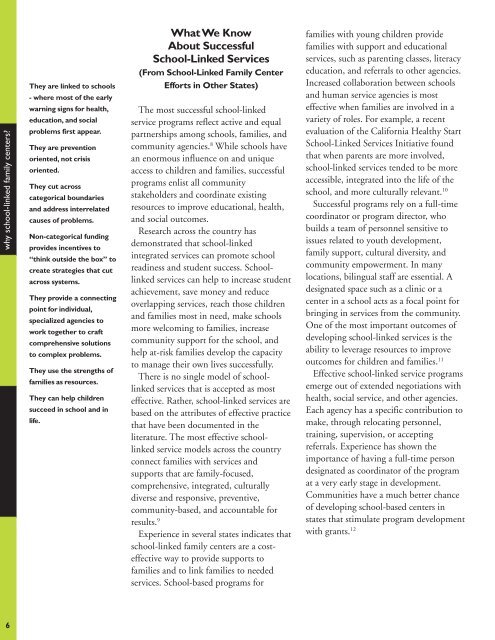School-Linked Services: Child Opportunity Zone Family Centers
School-Linked Services: Child Opportunity Zone Family Centers
School-Linked Services: Child Opportunity Zone Family Centers
Create successful ePaper yourself
Turn your PDF publications into a flip-book with our unique Google optimized e-Paper software.
why school-linked family centers?<br />
6<br />
They are linked to schools<br />
- where most of the early<br />
warning signs for health,<br />
education, and social<br />
problems first appear.<br />
They are prevention<br />
oriented, not crisis<br />
oriented.<br />
They cut across<br />
categorical boundaries<br />
and address interrelated<br />
causes of problems.<br />
Non-categorical funding<br />
provides incentives to<br />
“think outside the box” to<br />
create strategies that cut<br />
across systems.<br />
They provide a connecting<br />
point for individual,<br />
specialized agencies to<br />
work together to craft<br />
comprehensive solutions<br />
to complex problems.<br />
They use the strengths of<br />
families as resources.<br />
They can help children<br />
succeed in school and in<br />
life.<br />
What We Know<br />
About Successful<br />
<strong>School</strong>-<strong>Linked</strong> <strong>Services</strong><br />
(From <strong>School</strong>-<strong>Linked</strong> <strong>Family</strong> Center<br />
Efforts in Other States)<br />
The most successful school-linked<br />
service programs reflect active and equal<br />
partnerships among schools, families, and<br />
community agencies. 8 While schools have<br />
an enormous influence on and unique<br />
access to children and families, successful<br />
programs enlist all community<br />
stakeholders and coordinate existing<br />
resources to improve educational, health,<br />
and social outcomes.<br />
Research across the country has<br />
demonstrated that school-linked<br />
integrated services can promote school<br />
readiness and student success. <strong>School</strong>linked<br />
services can help to increase student<br />
achievement, save money and reduce<br />
overlapping services, reach those children<br />
and families most in need, make schools<br />
more welcoming to families, increase<br />
community support for the school, and<br />
help at-risk families develop the capacity<br />
to manage their own lives successfully.<br />
There is no single model of schoollinked<br />
services that is accepted as most<br />
effective. Rather, school-linked services are<br />
based on the attributes of effective practice<br />
that have been documented in the<br />
literature. The most effective schoollinked<br />
service models across the country<br />
connect families with services and<br />
supports that are family-focused,<br />
comprehensive, integrated, culturally<br />
diverse and responsive, preventive,<br />
community-based, and accountable for<br />
results. 9<br />
Experience in several states indicates that<br />
school-linked family centers are a costeffective<br />
way to provide supports to<br />
families and to link families to needed<br />
services. <strong>School</strong>-based programs for<br />
families with young children provide<br />
families with support and educational<br />
services, such as parenting classes, literacy<br />
education, and referrals to other agencies.<br />
Increased collaboration between schools<br />
and human service agencies is most<br />
effective when families are involved in a<br />
variety of roles. For example, a recent<br />
evaluation of the California Healthy Start<br />
<strong>School</strong>-<strong>Linked</strong> <strong>Services</strong> Initiative found<br />
that when parents are more involved,<br />
school-linked services tended to be more<br />
accessible, integrated into the life of the<br />
school, and more culturally relevant. 10<br />
Successful programs rely on a full-time<br />
coordinator or program director, who<br />
builds a team of personnel sensitive to<br />
issues related to youth development,<br />
family support, cultural diversity, and<br />
community empowerment. In many<br />
locations, bilingual staff are essential. A<br />
designated space such as a clinic or a<br />
center in a school acts as a focal point for<br />
bringing in services from the community.<br />
One of the most important outcomes of<br />
developing school-linked services is the<br />
ability to leverage resources to improve<br />
outcomes for children and families. 11<br />
Effective school-linked service programs<br />
emerge out of extended negotiations with<br />
health, social service, and other agencies.<br />
Each agency has a specific contribution to<br />
make, through relocating personnel,<br />
training, supervision, or accepting<br />
referrals. Experience has shown the<br />
importance of having a full-time person<br />
designated as coordinator of the program<br />
at a very early stage in development.<br />
Communities have a much better chance<br />
of developing school-based centers in<br />
states that stimulate program development<br />
with grants. 12



